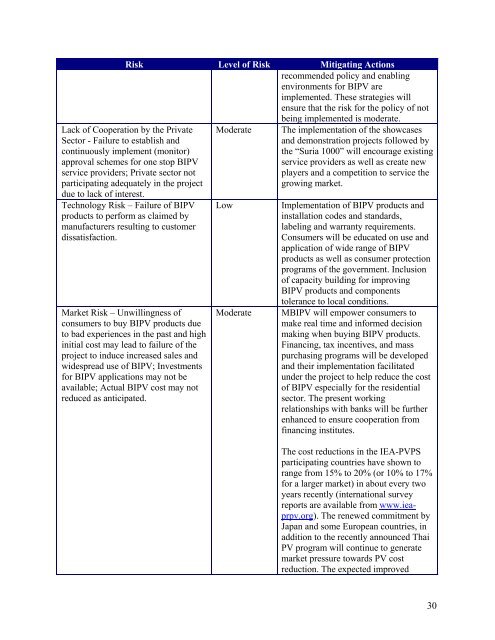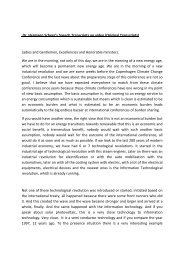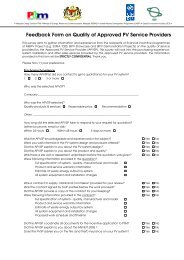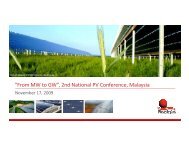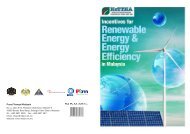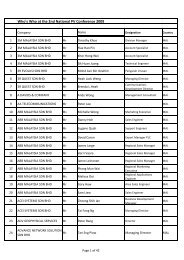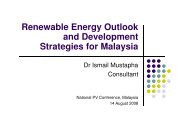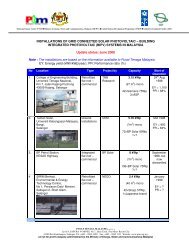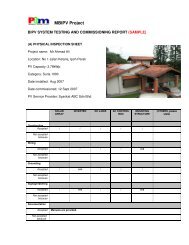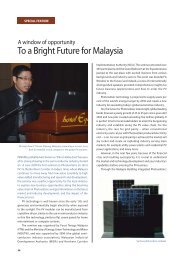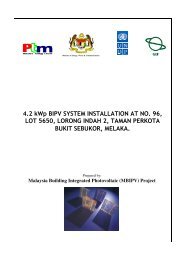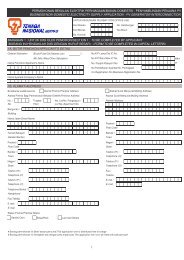Risk Level of Risk Mitigating Actionsrecommended policy and enablingenvironments for BIPV areimplemented. These strategies willensure that the risk for the policy of notbeing implemented is moderate.Lack of Cooperation by the PrivateSector - Failure to establish andcontinuously implement (monitor)approval schemes for one stop BIPVservice providers; Private sector notparticipating adequately in the projectdue to lack of interest.Technology Risk – Failure of BIPVproducts to perform as claimed bymanufacturers resulting to customerdissatisfaction.Market Risk – Unwillingness ofconsumers to buy BIPV products dueto bad experiences in the past and highinitial cost may lead to failure of theproject to induce increased sales andwidespread use of BIPV; Investmentsfor BIPV applications may not beavailable; Actual BIPV cost may notreduced as anticipated.ModerateLowModerateThe implementation of the showcasesand demonstration projects followed bythe “Suria 1000” will encourage existingservice providers as well as create newplayers and a competition to service thegrowing market.Implementation of BIPV products andinstallation codes and standards,labeling and warranty requirements.Consumers will be educated on use andapplication of wide range of BIPVproducts as well as consumer protectionprograms of the government. Inclusionof capacity building for improvingBIPV products and componentstolerance to local conditions.<strong>MBIPV</strong> will empower consumers tomake real time and informed decisionmaking when buying BIPV products.Financing, tax incentives, and masspurchasing programs will be developedand their implementation facilitatedunder the project to help reduce the costof BIPV especially for the residentialsector. The present workingrelationships with banks will be furtherenhanced to ensure cooperation fromfinancing institutes.The cost reductions in the IEA-PVPSparticipating countries have shown torange from 15% to 20% (or 10% to 17%for a larger market) in about every twoyears recently (international surveyreports are available from www.ieaprpv.org).The renewed commitment byJapan and some European countries, inaddition to the recently announced ThaiPV program will continue to generatemarket pressure towards PV costreduction. The expected improved30
OVERALLRisk Level of Risk Mitigating Actionscompetency level of the local BIPVindustry will also significantlycontribute to the overall cost reductionof BIPV in Malaysia.Moderate76. The overall project risk is moderate. The <strong>MBIPV</strong> is designed to facilitate close coordination andconsultation of the relevant stakeholders in each of the proposed activities. Activities that providepolicies, standards, guidelines and incentives, tools and procedures to implement BIPVprograms, information and education are sufficient to ensure mitigation of the risks. Governmentagencies, NGOs, manufacturers, and commercial and industrial establishments/associations havecommitted to financially support the project and use part of their budget in 2005 to 2010 for the<strong>MBIPV</strong> activities.SUSTAINABILITY77. BIPV is a proven reliable and in some cases already a cost-effective technology in theinternational market. In order to encourage, and sustain interest in the application of thistechnology, this project will build the technical capacity of the private and government sectors, todevelop, design and make use of the BIPV technology. The private sector, in particularly, hasexpressed interest in advancing the development of BIPV applications in a well orchestrated andcoordinated approach that will create a long-term sustainable market. It will also help create asustainable demand for and supply of BIPV systems through disseminating information,enhancing the market and developing the local industry towards BIPV products manufacturing.These efforts should establish a suitable environment for widespread adoption of grid-connectedBIPV technology as a viable RE technology in Malaysia.78. Sustainability of the project is ensured through the outputs of the different project components,e.g., endorsed policy and financial frameworks, updated standards and new technical guidelineson BIPV, optimized systems fitting the local climate, quality programs in place, informed andeducated consumers and policy/decision makers, increased know-how and upgraded capacity ofservice providers, easy accessible information center, enhanced R&D activities supported with anup-to-date testing facility and upgraded industry for local manufacturing. Component 3 of theproject will recommend an appropriate institutional and policy framework supported with anappropriate financing mechanism for a sustainable follow-up BIPV program to be implementedin the government policies at the end of the project.79. In the final year of the project, a follow-up national BIPV program will be designed consideringthe different achievements and lessons learned. The follow-up program, with a long-term targetthat is to be achieved in the 10th Malaysia Plan and in the subsequent 5-year development plansof the country, will create a significant impact to the local BIPV market with a possibility tospill-over to the neighboring countries. The national target will give stimulating signal to theindustry to expand their businesses and further reduces the cost for BIPV technology, due to theeconomies of scale. A follow-up National Roof-top Program within the 10th Malaysia Planperiod is expected to stimulate a sustainable BIPV growth of average 30% per annum, betweenthe years 2010 to 2020. With the expected institutional frameworks and financial incentives inplace, BIPV will possibly have a direct payback period of less than 15 years by the year 2020.31


